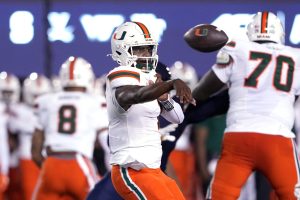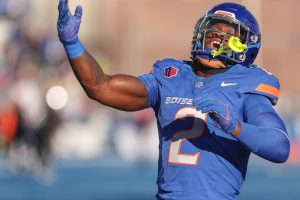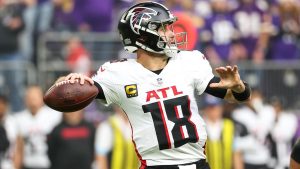Green Bay Packers general manager Brian Gutekunst has not been reluctant to wheel and deal in previous drafts, moving up or down to where he feels the board is strong.
In his first draft, Gutekunst traded back and then back up again in the first round, before selecting Jaire Alexander. He also traded up for Jordan Love in the 2020 draft. How likely is he to move from pick 23 this year, and will it be a trade up or down?
In truth, a trade up feels less likely than ever this year. The conventional wisdom is that this is not a particularly good year to have a high-ish pick, as the difference in quality between players is not vast once the few elite prospects have gone.
There are players who are projected to go before the Packers pick who would be popular with the fans if they managed to maneuver up to get, but they do not seem like the types of prospects Green Bay will be willing to give up extra draft capital for.
Between picks 11 and 15 on the consensus big board there is Tetairoa McMillan, Will Johnson, Kelvin Banks, Mykel Williams and Jahdae Barron.
None of those players have the elite speed Green Bay usually chases, at least according to the Relative Athletic Score (RAS) model.
McMillan, Johnson and Williams have incomplete testing, while Barron has really short arms and turns 24 years old this year. Banks plays offensive line, which is not a position the Packers are probably going to draft in Round 1 this year.
Shemar Stewart is ranked 16th on the consensus board, and is athletically what they look for, although he skipped the agility testing. Despite the Packers love of traits though, Stewart would still be the least productive pass rusher Gutekunst has drafted in any round.
Matthew Golden is ranked 20th, but would be the smallest receiver in terms of height/weight combo the Packers have drafted to play outside receiver going all the way back to the Ted Thompson days.
There is simply not a perfect Packers “type” prospect they would feel the need to go up and get this year.
A trade down is much more probable, with plenty of prospects they could be interested in projected to be drafted from pick 23 onwards on the consensus big board.
The likes of Derrick Harmon, Kenneth Grant, Grey Zabel, Emeka Egbuka, Maxwell Hairston, Shavon Revel Jr, Trey Amos, Tyleik Williams, Benjamin Morrison and Landon Jackson are all in the 23-50 range.
If the Packers have similar grades on some of these players, and have numerous options they would be happy with when they are on the clock at 23, they could well move back and try to pick up more draft capital on Day 2, which is the meat of this year’s draft.
Moving out of the first round entirely could even be beneficial, as the athletic benchmarks they look for ease up ever so slightly once they are outside the first round, potentially bringing some of the players mentioned into play at that point.
Despite Gutekunst telling the media he has not been told he cannot trade out of the first round just because the draft is in Green Bay, that is still a factor to consider.
It takes two to tango, and the Packers would need another team to be interested in moving up to pick 23, which in this draft, could be more difficult than others.
There might need to be a team who has only one first-round grade left and wants to go get them, or a team who wants to trade up for a quarterback.
Overall, the Packers will probably be all ears to trade offers which would see them move back, but whether they have enticing options to do so will depend on how the first 22 picks play out.
This article originally appeared on Packers Wire: How likely is first-round trade for Packers? Trade down more probable than trade up
Green Bay Packers general manager Brian Gutekunst has not been reluctant to wheel and deal in previous drafts, moving up or down to where he feels the board is strong.
In his first draft, Gutekunst traded back and then back up again in the first round, before selecting Jaire Alexander. He also traded up for Jordan Love in the 2020 draft. How likely is he to move from pick 23 this year, and will it be a trade up or down?
In truth, a trade up feels less likely than ever this year. The conventional wisdom is that this is not a particularly good year to have a high-ish pick, as the difference in quality between players is not vast once the few elite prospects have gone.
There are players who are projected to go before the Packers pick who would be popular with the fans if they managed to maneuver up to get, but they do not seem like the types of prospects Green Bay will be willing to give up extra draft capital for.
Between picks 11 and 15 on the consensus big board there is Tetairoa McMillan, Will Johnson, Kelvin Banks, Mykel Williams and Jahdae Barron.
None of those players have the elite speed Green Bay usually chases, at least according to the Relative Athletic Score (RAS) model.
McMillan, Johnson and Williams have incomplete testing, while Barron has really short arms and turns 24 years old this year. Banks plays offensive line, which is not a position the Packers are probably going to draft in Round 1 this year.
Shemar Stewart is ranked 16th on the consensus board, and is athletically what they look for, although he skipped the agility testing. Despite the Packers love of traits though, Stewart would still be the least productive pass rusher Gutekunst has drafted in any round.
Matthew Golden is ranked 20th, but would be the smallest receiver in terms of height/weight combo the Packers have drafted to play outside receiver going all the way back to the Ted Thompson days.
There is simply not a perfect Packers “type” prospect they would feel the need to go up and get this year.
A trade down is much more probable, with plenty of prospects they could be interested in projected to be drafted from pick 23 onwards on the consensus big board.
The likes of Derrick Harmon, Kenneth Grant, Grey Zabel, Emeka Egbuka, Maxwell Hairston, Shavon Revel Jr, Trey Amos, Tyleik Williams, Benjamin Morrison and Landon Jackson are all in the 23-50 range.
If the Packers have similar grades on some of these players, and have numerous options they would be happy with when they are on the clock at 23, they could well move back and try to pick up more draft capital on Day 2, which is the meat of this year’s draft.
Moving out of the first round entirely could even be beneficial, as the athletic benchmarks they look for ease up ever so slightly once they are outside the first round, potentially bringing some of the players mentioned into play at that point.
Despite Gutekunst telling the media he has not been told he cannot trade out of the first round just because the draft is in Green Bay, that is still a factor to consider.
It takes two to tango, and the Packers would need another team to be interested in moving up to pick 23, which in this draft, could be more difficult than others.
There might need to be a team who has only one first-round grade left and wants to go get them, or a team who wants to trade up for a quarterback.
Overall, the Packers will probably be all ears to trade offers which would see them move back, but whether they have enticing options to do so will depend on how the first 22 picks play out.
This article originally appeared on Packers Wire: How likely is first-round trade for Packers? Trade down more probable than trade up








